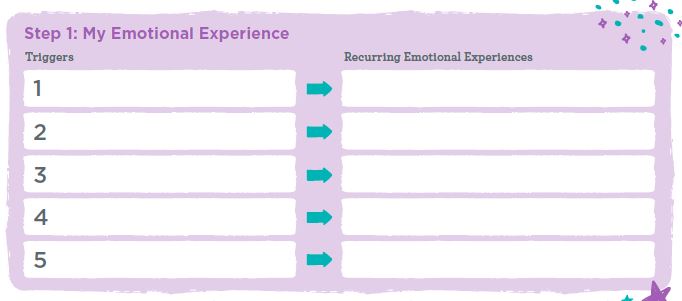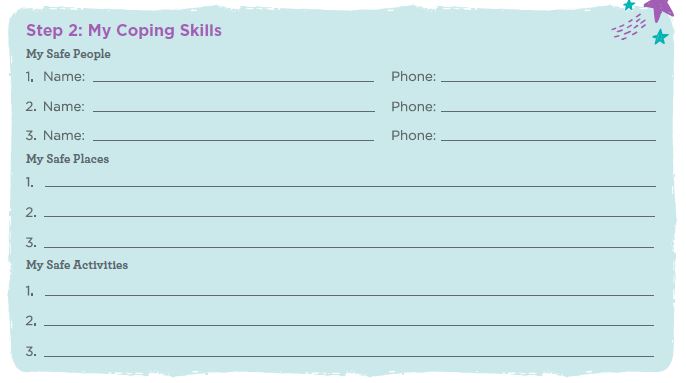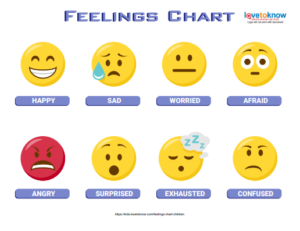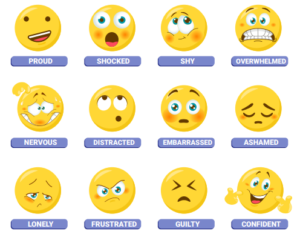How to Create an Emotion Regulation Plan with Your Child

An Emotion Regulation Plan is a tool that helps individuals recognize the emotions they’re feeling, think about why they’re feeling them, and identify ways to help manage those emotions. These plans can be especially helpful for kids as their brain is developing and they’re learning skills that will help them well into adulthood. Being able to regulate emotions is key to having healthy interpersonal relationships, positive experiences at school and work, and a more peaceful life.
What is an Emotion Regulation Plan?
An Emotion Regulation Plan can be used by anyone who might experience intense emotions (so, it’s for all of us!). Sometimes when we feel emotions such as frustration, excitement, anger, or sadness, we do things we didn’t mean to or that we regret later. Emotion Regulation Plans help us manage those emotions and respond appropriately.
Each plan is unique to the individual using it. Also, since we’re continuously growing and changing, our Emotion Regulation Plan can change too. It’s okay to make adjustments to your plan as you become more aware of yourself. You can even create a new plan that best fits your growth.
How to Create an Emotion Regulation Plan With Your Child
Talking about emotions and identifying how someone really feels can be tough. In the right situation with a supportive parent that is calm, caring, and understanding, the experience can be empowering and impactful.
In only three steps, you can create an Emotion Regulation Plan with your child. First, start by clicking here to download our template. Then follow these steps to fill it out:
STEP 1: Help your child identify three to five “triggers” they experience most often. A trigger is something that causes intense emotions. Triggers can be situations, people, smells, locations, etc. Write out what happens when they experience those triggers. What emotions do they feel? How does their body react?

STEP 2: Next, identify coping skills—safe people, places, and activities—to help develop positive habits and tame the intense emotions. If we don’t take the time to identify these or don’t make an effort to use them, we might instead use unhealthy coping skills such as binge eating, drinking alcohol/using drugs, or putting ourselves in unsafe situations.
-
- Safe People: These are individuals who make your child feel safe and listen when they need to talk. They may be family members, neighbors, friends or a school counselor. Make sure to write down phone numbers so they always know how to contact them.
- Safe Places: Think through places your child has available to them at most times. For example, you don’t want to list the zoo because it isn’t always open or accessible. List a place that is available, comforting and relaxing.
- Safe Activities: These are meant to distract your child and calm them down. Examples might be going for a walk, kicking a soccer ball, reading a book, playing games, dancing, etc. For younger kids, check out the Sesame Street in Communities website for several free activities like coloring pages, short stories, and more.

STEP 3: Evaluate if the plan worked. As your child experiences intense emotions, have them try out a few of their coping skills. If one doesn’t help them feel more regulated, try another from the list. Keep going until they find something that works. Once your child is regulated, talk about what did and didn’t work and make note of that. If they experience a trigger that isn’t listed on the plan and they’re likely to experience it again, add it to the plan. Remember, an Emotion Regulation Plan is meant to work for each individual, so adapt it to work best for them.

Click here to download the template.
Tips for Working Through This Process With Your Child
- Do this activity in a supportive and calm space with few distractions.
- Tell your child why you think this activity is important. Do your own Emotion Regulation Plan with them if you think it would be helpful.
- Let them do most of the talking. Offer suggestions if they ask.
- Do not minimize the emotions or experiences your child identifies. Respect their truth.
- If they pick coping skills that sound unrealistic, ask them to walk you through what that would look like in real life. Provide simple feedback. If your child is resistant, don’t get into a power struggle. This is a learning experience for them and it will come with time.
- Provide breaks during this activity as needed. It can be a lot to process and breaks are rejuvenating.
- If they have a hard time identifying triggers or coping skills, that’s okay. It can take some time for them to understand themselves and what they need to make their plan successful.
- It can be helpful to hang their plan up (possibly in their room or on the refrigerator), save a picture of it on their phone, or keep a copy in their backpack so they can refer to it whenever they need it.
- Help your child identify the emotion they are feeling and educate them about all emotions. Check out this feelings chart from LoveToKnow:
If you’re concerned about your child’s behavior or worried they’re struggling with their mental health, learn more about the warning signs to watch for and how to know when it might be time for professional help.
About Camber Children’s Mental Health (Previously KVC Hospitals)
We all need connection, and Camber is here to be yours. If you know a child between the ages 6 to 18 who is struggling with their mental health, we can help! We accept new clients 24 hours a day, 7 days a week at our treatment centers in Kansas City, Wichita and Hays. We take a patient-centered approach to treatment and provide education and therapeutic services to help the whole family unit. For more information and to find services near you, call us at (913) 890-7468.






